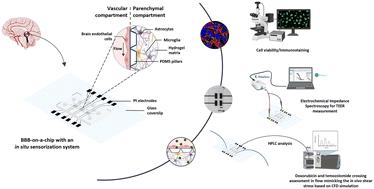Our official English website, www.x-mol.net, welcomes your
feedback! (Note: you will need to create a separate account there.)
Real-time monitoring of a 3D blood–brain barrier model maturation and integrity with a sensorized microfluidic device
Lab on a Chip ( IF 6.1 ) Pub Date : 2024-10-07 , DOI: 10.1039/d4lc00633j Maria Cristina Ceccarelli, Marie Celine Lefevre, Attilio Marino, Francesca Pignatelli, Katarzyna Krukiewicz, Matteo Battaglini, Gianni Ciofani
Lab on a Chip ( IF 6.1 ) Pub Date : 2024-10-07 , DOI: 10.1039/d4lc00633j Maria Cristina Ceccarelli, Marie Celine Lefevre, Attilio Marino, Francesca Pignatelli, Katarzyna Krukiewicz, Matteo Battaglini, Gianni Ciofani

|
A significant challenge in the treatment of central nervous system (CNS) disorders is represented by the presence of the blood–brain barrier (BBB), a highly selective membrane that regulates molecular transport and restricts the passage of pathogens and therapeutic compounds. Traditional in vivo models are constrained by high costs, lengthy experimental timelines, ethical concerns, and interspecies variations. In vitro models, particularly microfluidic BBB-on-a-chip devices, have been developed to address these limitations. These advanced models aim to more accurately replicate human BBB conditions by incorporating human cells and physiological flow dynamics. In this framework, here we developed an innovative microfluidic system that integrates thin-film electrodes for non-invasive, real-time monitoring of BBB integrity using electrochemical impedance spectroscopy (EIS). EIS measurements showed frequency-dependent impedance changes, indicating BBB integrity and distinguishing well-formed from non-mature barriers. The data from EIS monitoring was confirmed by permeability assays performed with a fluorescence tracer. The model incorporates human endothelial cells in a vessel-like arrangement to mimic the vascular component and three-dimensional cell distribution of human astrocytes and microglia to simulate the parenchymal compartment. By modeling the BBB-on-a-chip with an equivalent circuit, a more accurate trans-endothelial electrical resistance (TEER) value was extracted. The device demonstrated successful BBB formation and maturation, confirmed through live/dead assays, immunofluorescence and permeability assays. Computational fluid dynamics (CFD) simulations confirmed that the device mimics in vivo shear stress conditions. Drug crossing assessment was performed with two chemotherapy drugs: doxorubicin, with a known poor BBB penetration, and temozolomide, conversely a specific drug for CNS disorders and able to cross the BBB, to validate the model predictive capability for drug crossing behavior. The proposed sensorized microfluidic device represents a significant advancement in BBB modeling, offering a versatile platform for CNS drug development, disease modeling, and personalized medicine.
中文翻译:

使用传感器化微流控设备实时监测 3D 血脑屏障模型的成熟度和完整性
治疗中枢神经系统 (CNS) 疾病的一个重大挑战是血脑屏障 (BBB) 的存在,BBB 是一种高度选择性的膜,可调节分子运输并限制病原体和治疗化合物的通过。传统的体内模型受到高成本、漫长的实验时间、伦理问题和物种间差异的限制。体外模型,特别是微流体 BBB-on-a-chip 器件,已经被开发出来来解决这些限制。这些先进的模型旨在通过结合人类细胞和生理流动动力学来更准确地复制人类 BBB 状况。在这个框架中,我们开发了一种创新的微流体系统,该系统集成了薄膜电极,用于使用电化学阻抗谱 (EIS) 对 BBB 完整性进行无创实时监测。EIS 测量显示与频率相关的阻抗变化,表明 BBB 完整性并区分形状良好的屏障和非成熟屏障。通过使用荧光示踪剂进行的渗透性测定来确认来自 EIS 监测的数据。该模型将人类内皮细胞以血管状排列,以模拟人类星形胶质细胞和小胶质细胞的血管成分和三维细胞分布,以模拟实质隔室。通过使用等效电路对 BBB-on-a-chip 进行建模,提取出更准确的跨内皮电阻 (TEER) 值。该设备展示了 BBB 的成功形成和成熟,通过活/死测定、免疫荧光和通透性测定得到证实。计算流体动力学 (CFD) 仿真证实,该设备模拟了体内剪切应力条件。 使用两种化疗药物进行药物交叉评估:已知 BBB 渗透性较差的阿霉素和替莫唑胺,相反,一种治疗 CNS 疾病的特异性药物,能够穿过 BBB,以验证药物交叉行为的模型预测能力。所提出的传感器化微流控设备代表了 BBB 建模的重大进步,为 CNS 药物开发、疾病建模和个性化医疗提供了一个多功能平台。
更新日期:2024-10-07
中文翻译:

使用传感器化微流控设备实时监测 3D 血脑屏障模型的成熟度和完整性
治疗中枢神经系统 (CNS) 疾病的一个重大挑战是血脑屏障 (BBB) 的存在,BBB 是一种高度选择性的膜,可调节分子运输并限制病原体和治疗化合物的通过。传统的体内模型受到高成本、漫长的实验时间、伦理问题和物种间差异的限制。体外模型,特别是微流体 BBB-on-a-chip 器件,已经被开发出来来解决这些限制。这些先进的模型旨在通过结合人类细胞和生理流动动力学来更准确地复制人类 BBB 状况。在这个框架中,我们开发了一种创新的微流体系统,该系统集成了薄膜电极,用于使用电化学阻抗谱 (EIS) 对 BBB 完整性进行无创实时监测。EIS 测量显示与频率相关的阻抗变化,表明 BBB 完整性并区分形状良好的屏障和非成熟屏障。通过使用荧光示踪剂进行的渗透性测定来确认来自 EIS 监测的数据。该模型将人类内皮细胞以血管状排列,以模拟人类星形胶质细胞和小胶质细胞的血管成分和三维细胞分布,以模拟实质隔室。通过使用等效电路对 BBB-on-a-chip 进行建模,提取出更准确的跨内皮电阻 (TEER) 值。该设备展示了 BBB 的成功形成和成熟,通过活/死测定、免疫荧光和通透性测定得到证实。计算流体动力学 (CFD) 仿真证实,该设备模拟了体内剪切应力条件。 使用两种化疗药物进行药物交叉评估:已知 BBB 渗透性较差的阿霉素和替莫唑胺,相反,一种治疗 CNS 疾病的特异性药物,能够穿过 BBB,以验证药物交叉行为的模型预测能力。所提出的传感器化微流控设备代表了 BBB 建模的重大进步,为 CNS 药物开发、疾病建模和个性化医疗提供了一个多功能平台。































 京公网安备 11010802027423号
京公网安备 11010802027423号